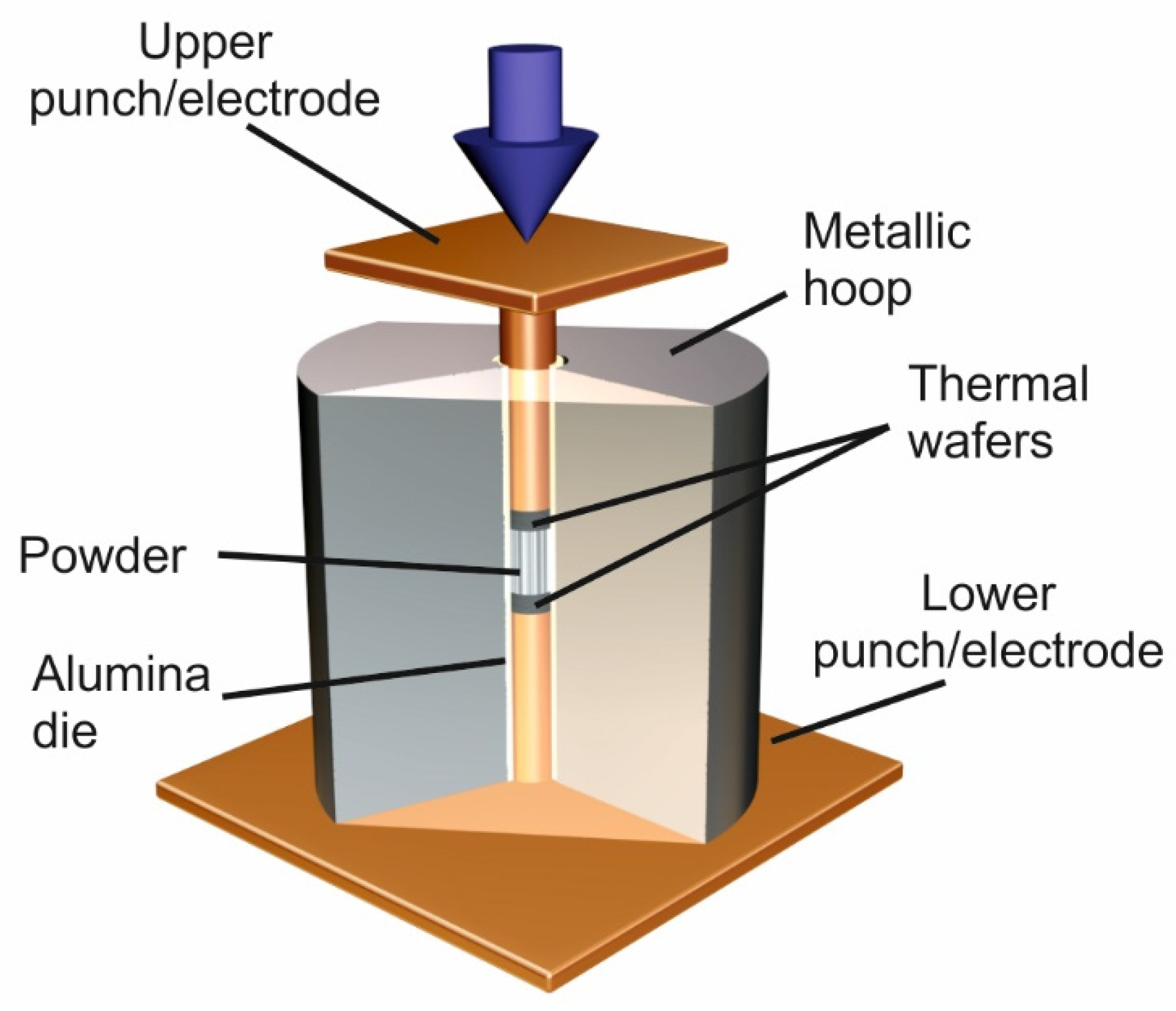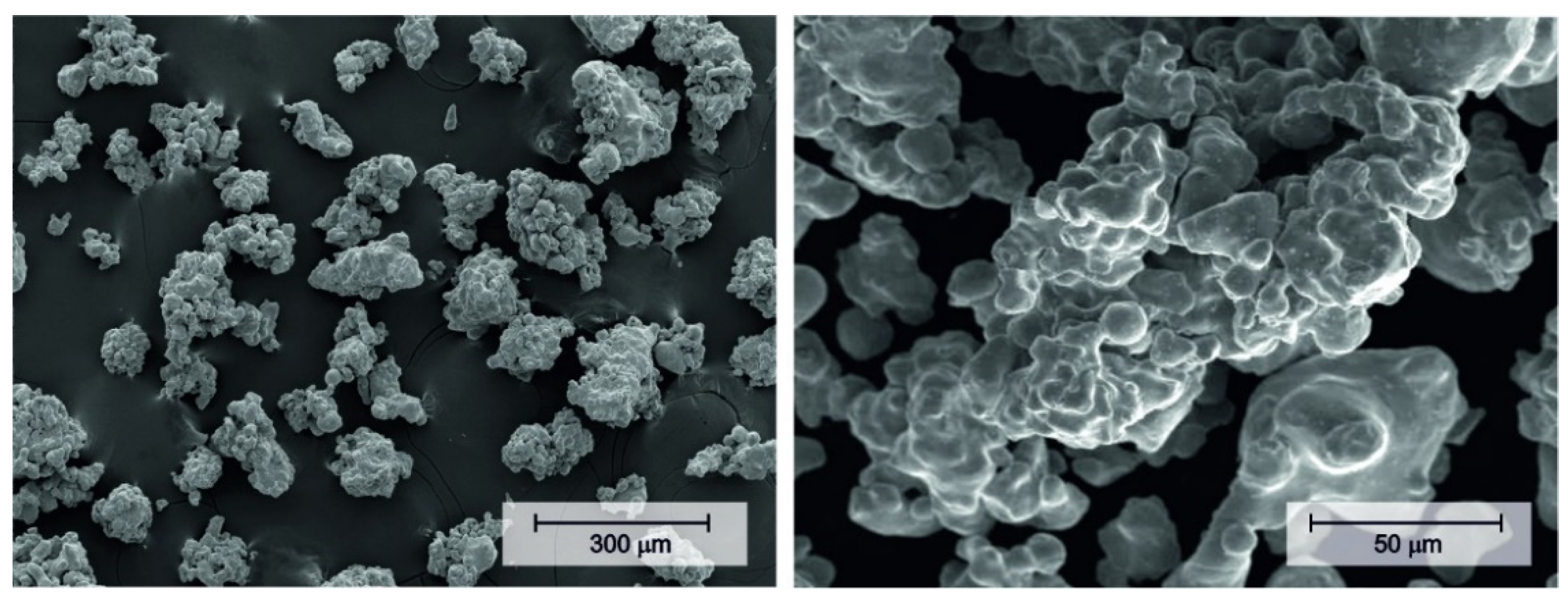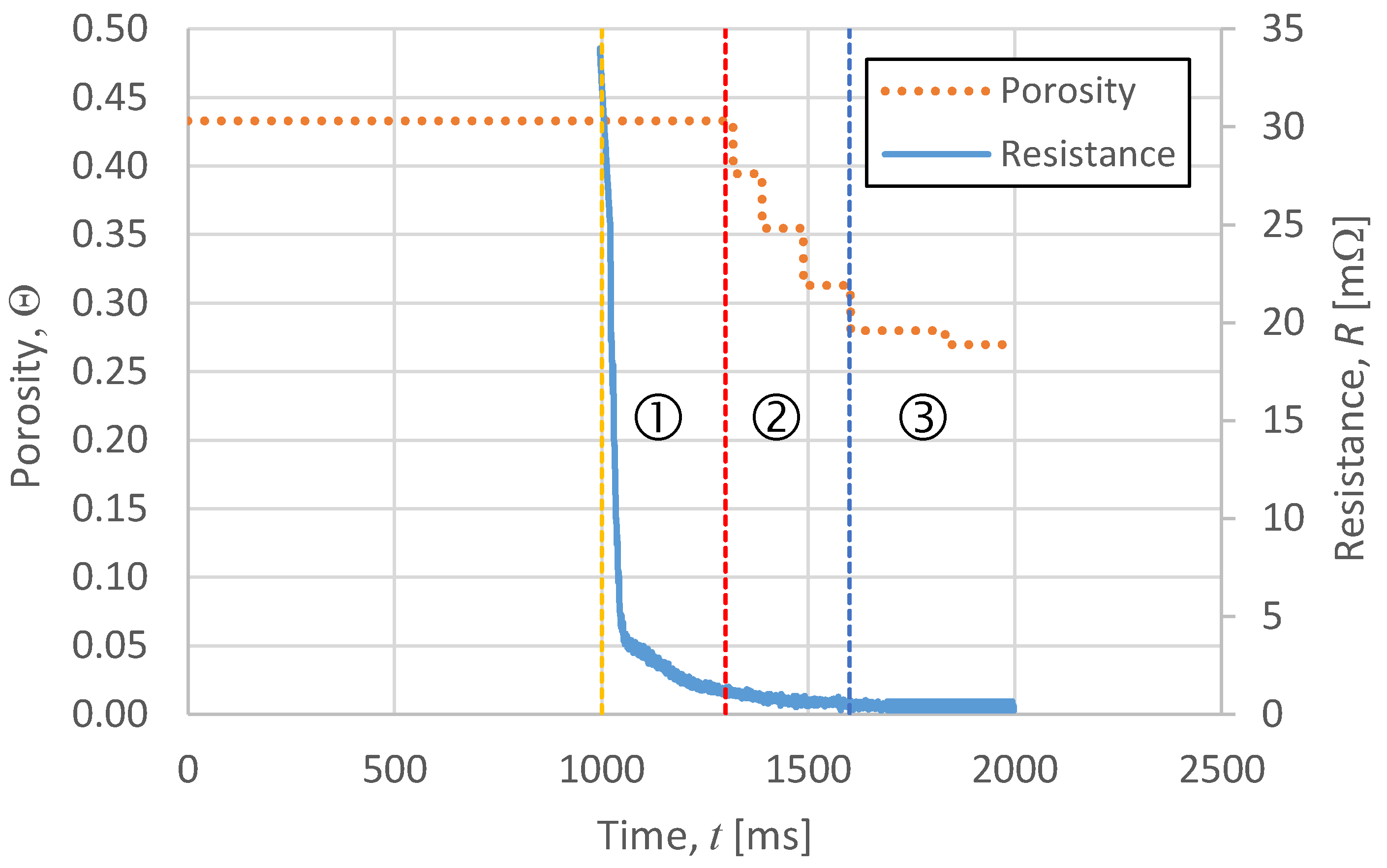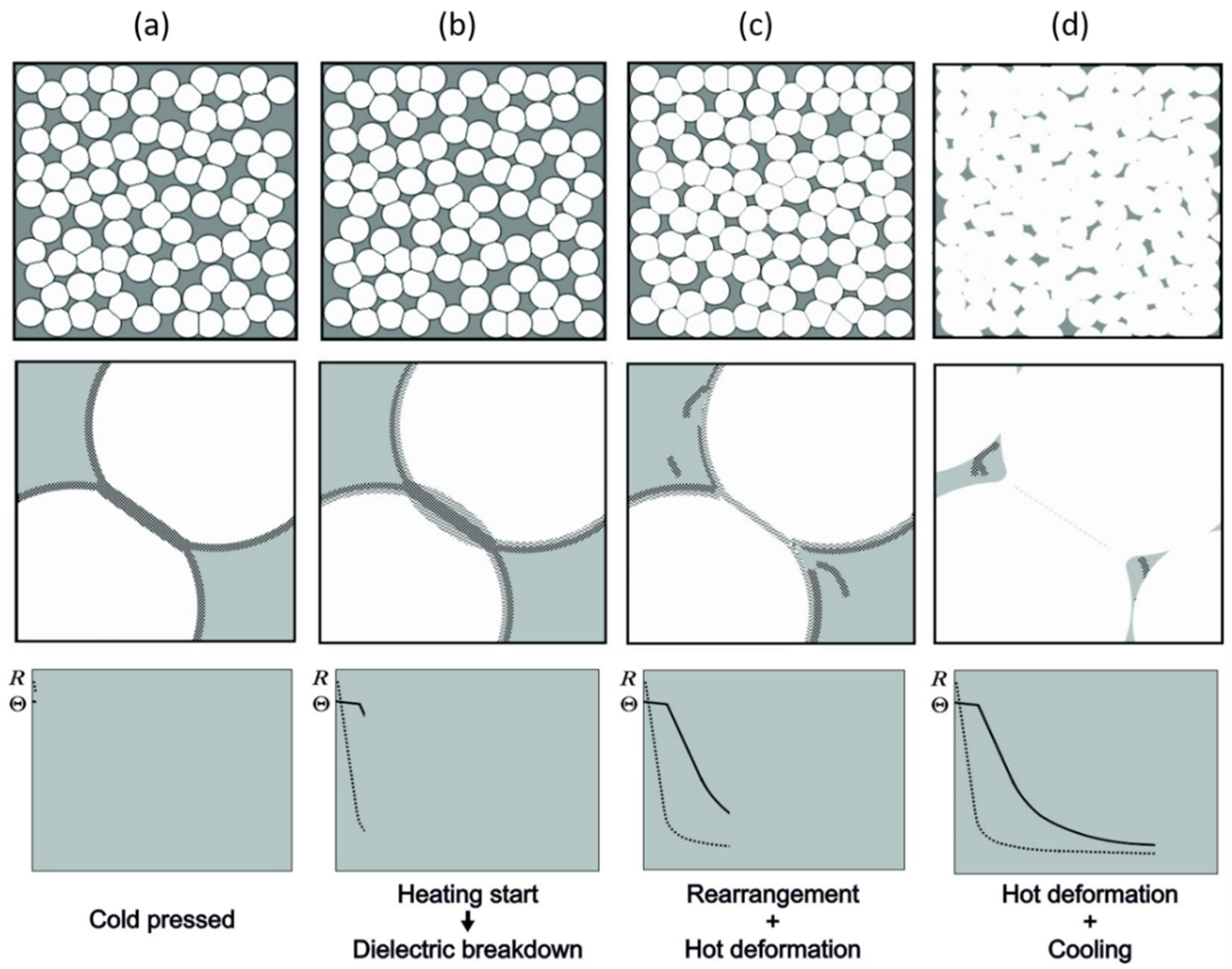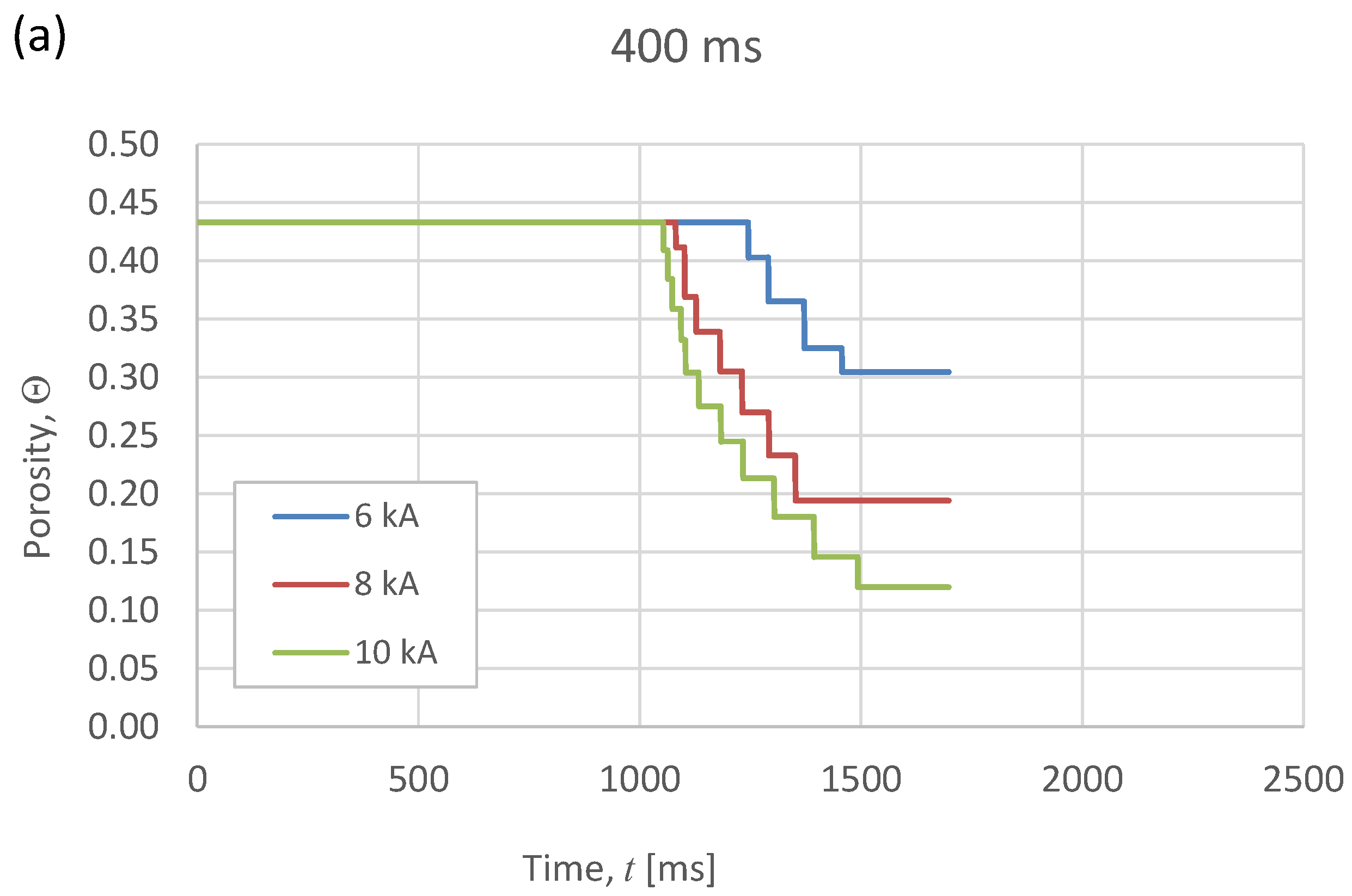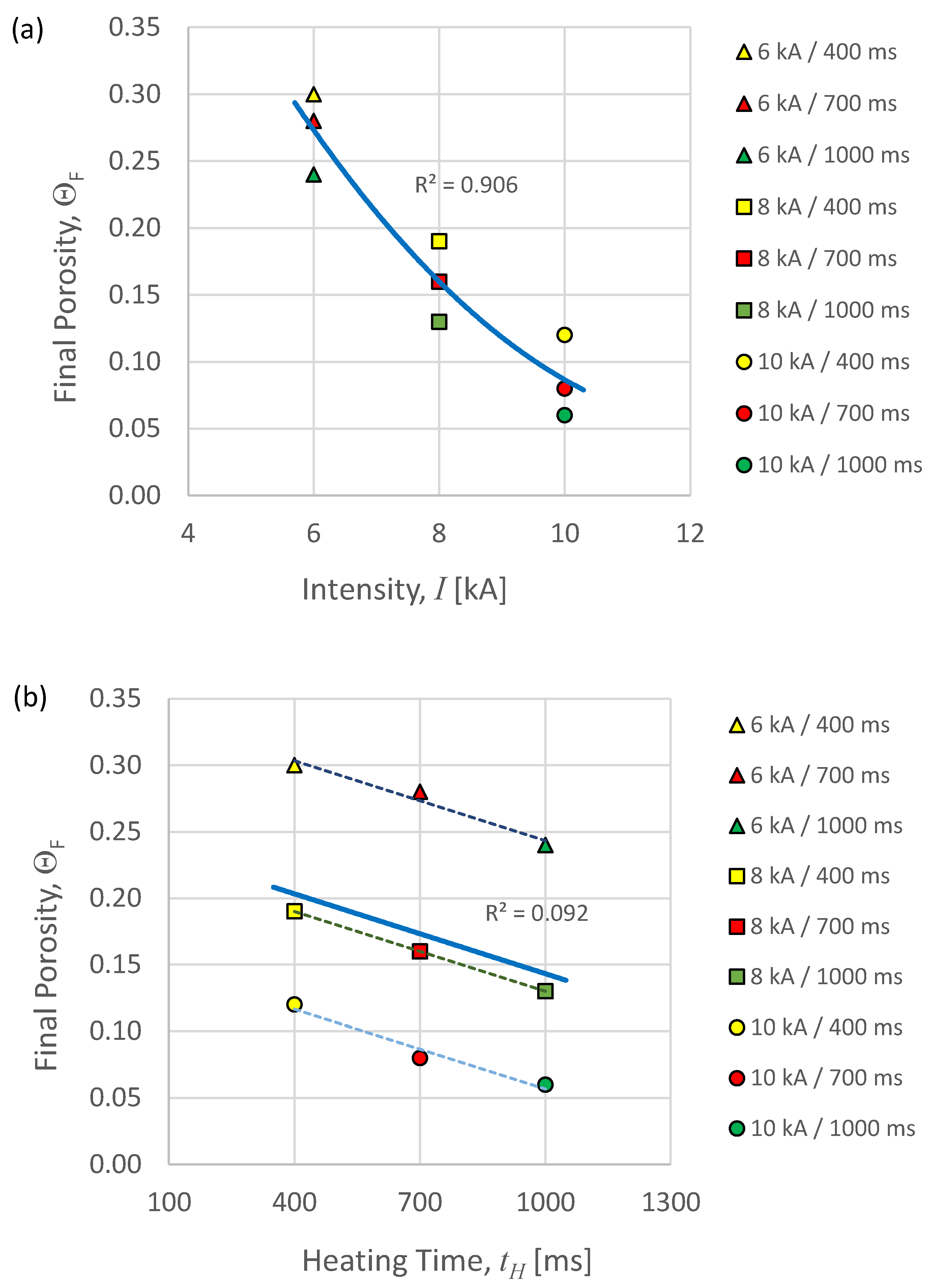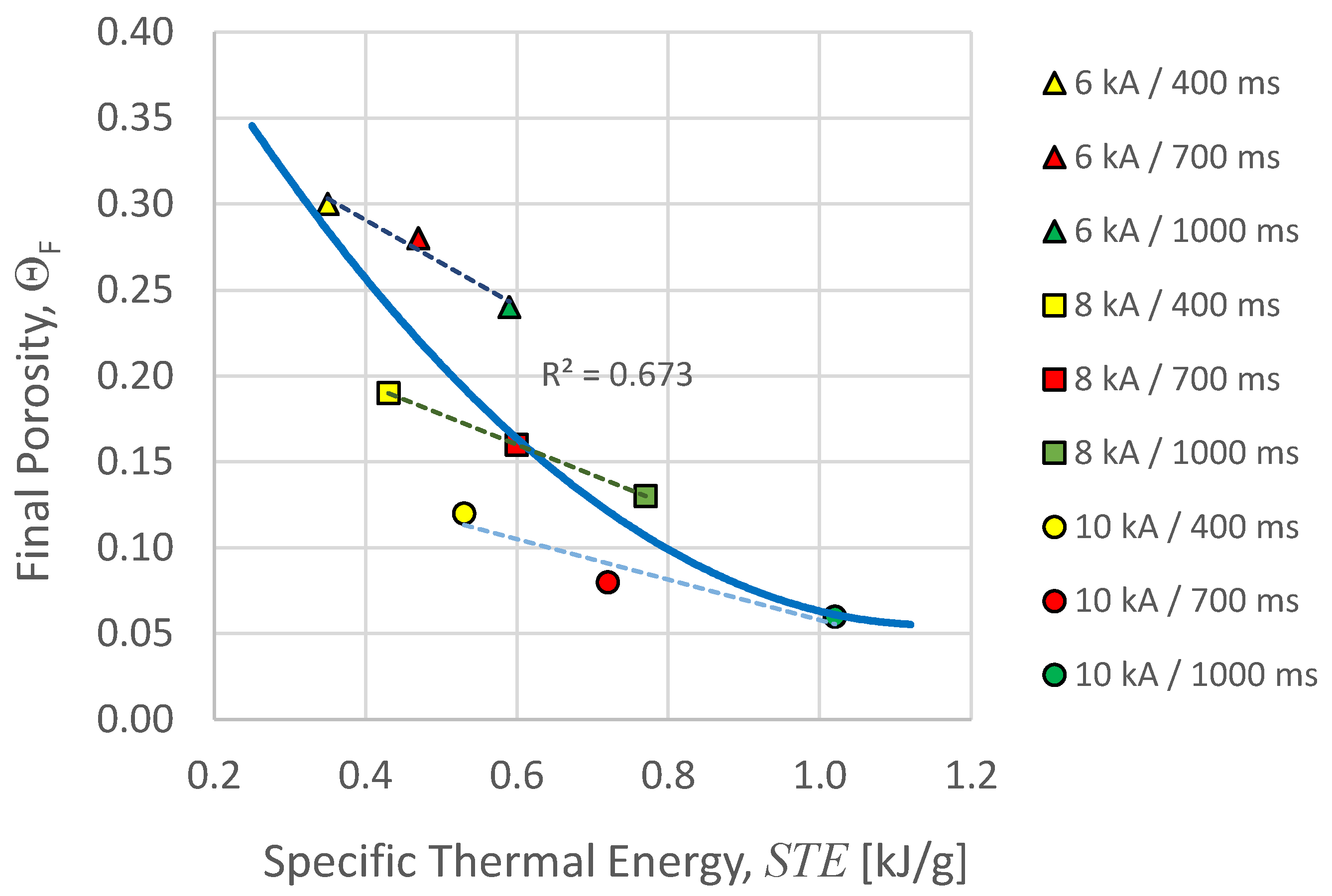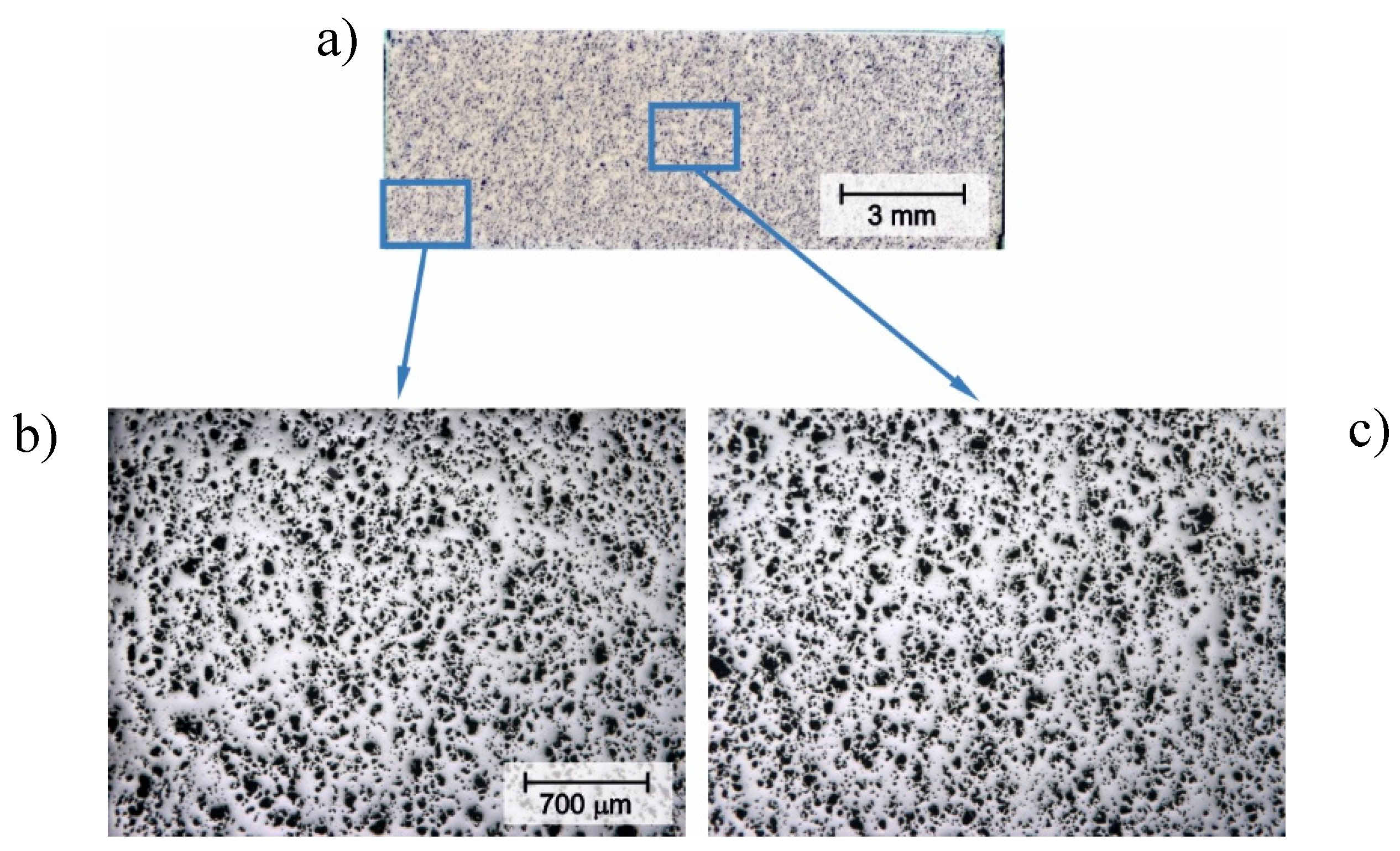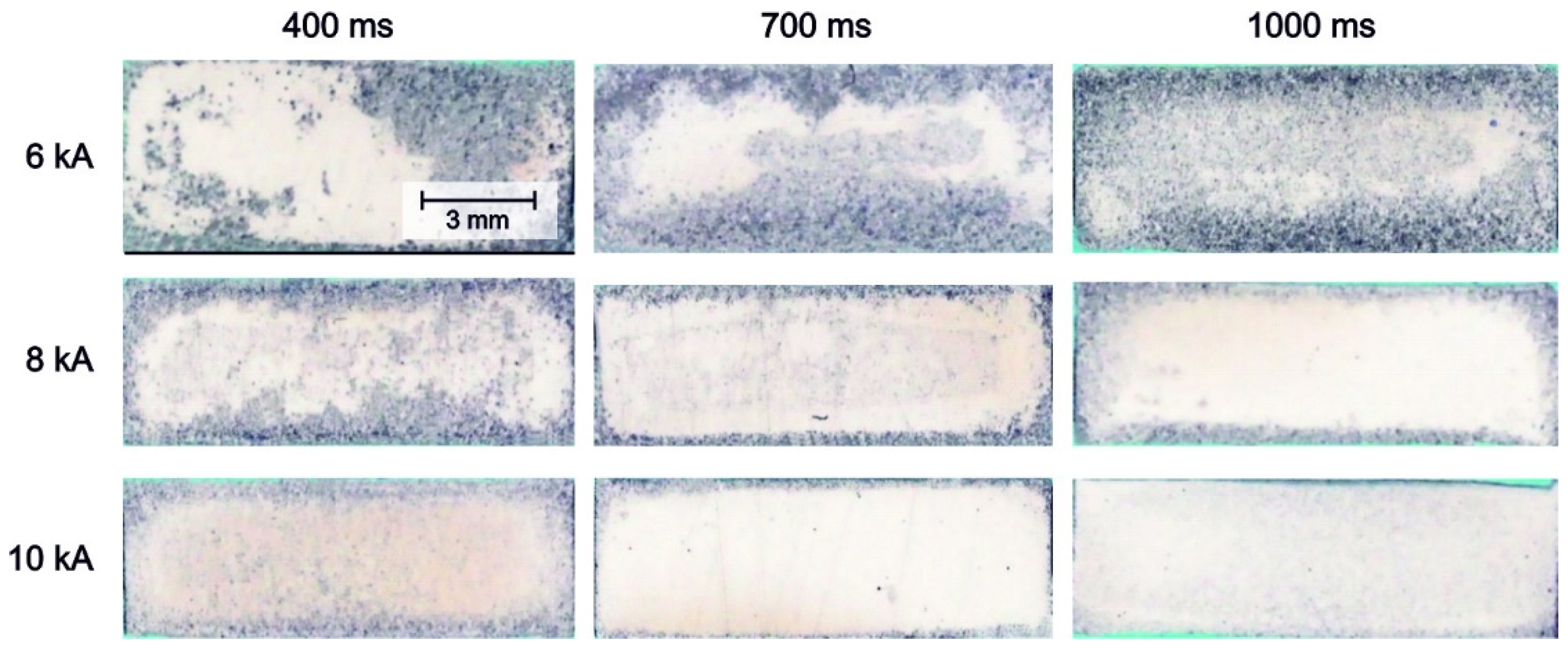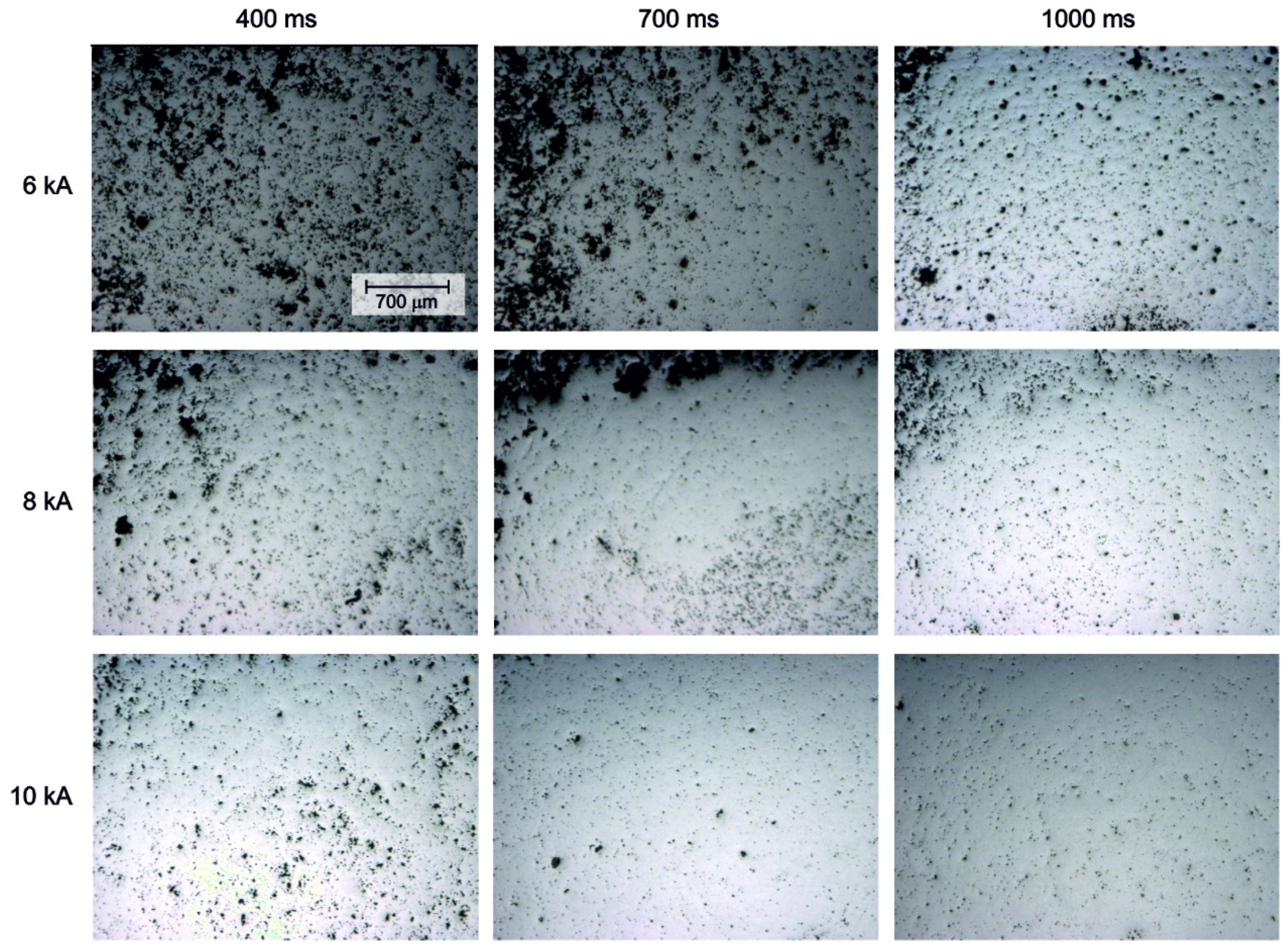1. Introduction
The electricity can be used to sinter a conductive powder mass that is passed through by the current, as has been suggested numerous times during the last century, and still remaining as an issue of extraordinary interest at present. The progress of the different modalities of electrical sintering, usually known under the common name of FAST (field assisted sintering techniques), has been reviewed in detail by Grasso et al. [
1].
Although with a common name, there are important differences among these techniques, mainly due to: (a) the characteristics of the power source, (b) the electrical features of the die containing the powders, and (c) the time that process lasts (from microseconds to minutes). This strongly influences the physical phenomena taking place in the different processes.
Most probably, the FAST modality most widely studied is the so called spark plasma sintering (SPS), where a pulsed DC current directly passes through a graphite die, as well as through the powder compact, in case of conductive samples. This facilitates a relatively high heating rate (up to 1000 K/min), hence the sintering process being generally quite fast (within a few minutes). The main advantages of the technique are the possibility of sintering both conductive and non-conductive powders, achieving a reasonably uniform temperature distribution, whereas its disadvantages are the need of a vacuum system and complicated electronics capable of controlling the high-power pulsating current to be generated. The pulsed current, besides the Joule heating, is supposed to favor the mobility of the atoms on the particles surface, which would cause plasma and discharges between particles. Whether plasma is generated has not yet been confirmed, especially when non-conductive ceramic powders are compacted.
However, in case of sintering conductive powders, the equipment needed to undertake electrical consolidation can be greatly simplified. Regarding the many conceived modalities, maybe the simplest is one of the firstly proposed, consisting in a high intensity and low voltage electrical current passing through a powder mass of conductive powders placed inside an insulating die, and being simultaneously under pressure. This is therefore a hot consolidation technique, where the heat is generated in the powder itself by Joule effect. Such technique was described by Taylor in 1933 [
2], and systematically studied later by Lenel [
3], who coined the term ‘electrical resistance sintering’ (ERS) under pressure.
Among the advantages of this technique, as compared to the traditional route of cold pressing followed by furnace sintering [
4,
5], it should be considered: (1) the use of relatively low pressures (around 100 MPa) to reach high densification rates; (2) the need of very short dwelling times (around 1 s); and (3) the possible option of sintering in air, without protective atmospheres. The main drawbacks come from the difficulty of getting a homogeneous temperature distribution inside the powder mass, and from finding the proper die material with a good durability. Other drawbacks arise from the insufficient theoretical knowledge that still exists of the various mechanisms involved [
6]. In spite of this, the interest towards the electrical sintering techniques has been growing rapidly in the last 30 years, mainly in applications involving hard-to-sinter materials, such as amorphous or nanocrystalline structures, nanocomposites, hard metals, and refractory materials [
7,
8].
On the other hand, it is a well-known fact [
9] the problems arising during conventional sintering of highly oxidized particles when reducing atmospheres are not used. The oxide layer act to impede atomic diffusion and metal-metal contacts between particles, therefore resulting in a deficient sintering.
In this paper, the novel medium frequency electrical resistance sintering (MF-ERS) technology will be used with oxidized iron particles. Medium frequency technology is a loan from the field of resistance welding. This technology has been extensively tested and its benefits in improving electronic current control and reducing the size of the required transformers are well known. The adaptation of a welding machine for the new consolidation task is therefore simple, economical, and free of prototyping steps. The compacts densification and electrical resistance evolution during the MF-ERS process will be registered and related to the observed microstructure. Also, metallographic observations of diametrical sections of the MF-ERS compacts will be compared with those obtained by the conventional powder metallurgy (PM) route.
Author Contributions
J.M.M. and F.G.C. designed the experiences, analyzed results and wrote the manuscript, F.T., R.A. and E.S.C. obtained the experimental results, J.C. worked on the characterization of the starting material.
Funding
Financial support of the Ministerio de Economía y Competitividad (Spain) and Feder (EU) through the research projects DPI2015-69550-C2-1-P and DPI2015-69550-C2-2-P are gratefully acknowledged.
Acknowledgments
The authors also wish to thank the technicians J. Pinto, M. Madrid, and M. Sánchez (University of Seville, Spain) for experimental assistance.
Conflicts of Interest
The authors declare no conflict of interest.
References
- Grasso, S.; Sakka, Y.; Maizza, G. Electric current activated/assisted sintering (ECAS): A review of patents 1906–2008. Sci. Technol. Adv. Mater. 2009, 10, 053001. [Google Scholar] [CrossRef] [PubMed]
- Taylor, G.F. Apparatus for Making Hard Metal Compositions. U.S. Patent 1896854, 7 February 1933. [Google Scholar]
- Lenel, F.V. Resistance sintering under pressure. JOM 1955, 203, 158–167. [Google Scholar] [CrossRef]
- Cintas, J.; Montes, J.M.; Cuevas, F.G.; Gallardo, J.M. Influence of PCA content on mechanical properties of sintered MA aluminium. In Advanced Materials Forum Iii, Pts 1 and 2; Vilarinho, P.M., Ed.; Trans Tech Publications Ltd.: Zurich-Uetikon, Switzerland, 2006; Volumes 514–516, pp. 1279–1283. [Google Scholar]
- Cintas, J.; Montes, J.M.; Cuevas, F.G.; Gallardo, J.M. Influence of PCA content on mechanical properties of sintered MA aluminium. J. Mater. Sci. 2005, 40, 3911–3915. [Google Scholar] [CrossRef]
- Anselmi-Tamburini, U.; Groza, J.R. Critical assessment: Electrical field/current application—A revolution in materials processing/sintering? Mater. Sci. Technol. 2017, 33, 1855–1862. [Google Scholar] [CrossRef]
- Ohji, T.; Singh, M.; Halbig, M.; Moon, K.I.; Fukushima, M.; Gyekenyesi, A. (Eds.) Advanced Processing and Manufacturing Technologies for Structural and Multifunctional Materials III; Wiley/The American Ceramic Society: Hoboken, NJ, USA, 2017; Volume 37, ISBN 978-1-119-32170-5. [Google Scholar]
- Kim, S.Y.; Lee, G.Y.; Park, G.H.; Kim, H.-A.; Lee, A.Y.; Scudino, S.; Prashanth, K.G.; Kim, D.H.; Eckert, J.; Lee, M.H. High strength nanostructured Al-based alloys through optimized processing of rapidly quenched amorphous precursors. Sci. Rep. 2018, 8, 1090. [Google Scholar] [CrossRef] [PubMed]
- ASM Handbooks. Powder Metal Technologies and Applications; Klar, E., Ed.; American Society for Metals: Geauga County, OH, USA, 1998; Chapter 4; Volume 7, pp. 360–370. [Google Scholar]
- MPIF Standard 4. Determination of Apparent Density of Free-Flowing Metal Powders Using the Hall Apparatus; Metal Powder Industries Federation (MPIF): Princeton, NJ, USA, 2016. [Google Scholar]
- MPIF Standard 46. Determination of tap density of metal powders. In Standard Test Methods for Metal Powders and Powder Metallurgy Products; Metal Powder Industries Federation (MPIF): Princeton, NJ, USA, 2016. [Google Scholar]
- Ugarteche, C.V.; Furlan, K.P.; Pereira, R.D.; Trindade, G.; Binder, R.; Binder, C.; Klein, A.N. Effect of Microstructure on the Thermal Properties of Sintered Iron-copper Composites. Mater. Res. 2015, 18, 1176–1182. [Google Scholar] [CrossRef]
- Bardhan, P.K.; Patra, S.; Sutradhar, G. Analysis of Density of Sintered Iron Powder Component Using the Response Surface Method. Mater. Sci. Appl. 2010, 1, 152–157. [Google Scholar] [CrossRef]
- Tsuda, N.; Nasu, K.; Fujimori, A.; Siratori, K. Electronic Conduction in Oxides, 2nd ed.; Springer: Berlin/Heidelberg, Germany, 2000; ISBN 3-50-66956-6. [Google Scholar]
- Kingery, W.D.; Bowen, H.K.; Uhlmann, D.R. Introduction to Ceramics, 2nd ed.; John Willey & Sons: New York, NY, USA, 1960; ISBN-13: 978-0471478607. [Google Scholar]
- Montes, J.M.; Cuevas, F.G.; Cintas, J. Electrical resistivity of metal powder aggregates. Metall. Mater. Trans. B 2007, 38, 957–964. [Google Scholar] [CrossRef]
- Garino, T.J. Electrical Behavior of Oxidized Metal Powders during and after Compaction. J. Mater. Res. 2002, 17, 2691–2697. [Google Scholar] [CrossRef]
- Murakami, T.; Akagi, T.; Kasai, E. Development of porous iron based material by slag foaming and its reduction. In Proceedings of the 8th International Conference on Porous Metals and Metallic Foams, Raleigh, NC, USA, 23–26 June 2013; Rabiei, A., Ed.; Elsevier Science Bv: Amsterdam, The Netherlands, 2014; Volume 4, pp. 27–32. [Google Scholar] [CrossRef]
Figure 1.
Sketch of punches and die used in MF-ERS experiences.
Figure 2.
SEM micrograph of the WPL200 Fe powder to be consolidated by MF-ERS.
Figure 3.
Typical sequence in an MF-ERS experiment, showing the pressure, and current intensity in the different stages. In all the experiments, the cold-compaction and cooling periods lasted 1000 and 300 ms, respectively.
Figure 4.
Porosity and electrical resistance evolution in an arbitrarily selected MF-ERS experiment. The vertical line at 1000 ms marks the beginning of the current passing. The other vertical lines separate the process stages discussed in the text. The serrated shape of the porosity curve is a consequence of the noise reduction function of the displacement sensor.
Figure 5.
Microscopic interpretation of the different stages of the MF-ERS process. (a) Initial status with oxidized powder particles under compression; (b) with heating, the oxide resistivity decays, although still not affecting the porosity; (c) after a sufficiently high temperature is reached in particle contacts, pressure provokes a particles rearrangement with mechanical descaling of the oxide layers, and a high densification takes place; (d) when rearrangement is no further possible, densification is due to particles hot deformation with a low variation of porosity and resistance.
Figure 6.
Evolution of the global porosity Θ, as a function of the current intensity, for different heating times: (a) 400 ms, (b) 700 ms, and (c) 1000 ms. The intensity starts passing through the specimen after 1000 ms and stops 300 ms before the end of the process.
Figure 7.
Compacts final porosity (ΘF) versus (a) intensity and (b) heating time, for the different MF-ERS experiments. The continuous lines in both graphs represent the trend of the whole data cloud. The discontinuous lines in (b) describe the trends of experiences carried out with the same current intensity.
Figure 8.
Compacts final porosity (ΘF) versus released specific thermal energy (STE) for the different MF-ERS experiments. The continuous line describes the trend of the whole data cloud, whereas the discontinuous lines correspond to the trends of experiences carried out with the same current intensity.
Figure 9.
(a) Macrograph, and micrographs showing the porosity distribution at (b) the corner and (c) center of a diametrical section of a compact conventionally consolidated.
Figure 10.
Porosity distribution in MF-ERS Fe compacts. White areas (more reflecting) indicate a lower porosity content.
Figure 11.
Micrographs showing the porosity distribution in a corner of diametrical sections of MF-ERS compacts consolidated under different conditions.
Figure 12.
Micrographs showing the porosity distribution at the center of diametrical sections of MF-ERS compacts consolidated under different conditions.
Table 1.
Values of the compacts final porosity (ΘF) in function of the intensity (in kA) and heating time (in ms) for the different MF-ERS experiments.
| | Heating Time |
|---|
| 400 ms | 700 ms | 1000 ms |
|---|
| Intensity | 6 kA | 0.30 | 0.28 | 0.24 |
| 8 kA | 0.19 | 0.16 | 0.13 |
| 10 kA | 0.12 | 0.08 | 0.06 |
Table 2.
Values of the STE (in kJ/g) in function of the intensity (in kA) and heating time (in ms) for the different MF-ERS experiments
| | Heating Time |
|---|
| 400 ms | 700 ms | 1000 ms |
|---|
| Intensity | 6 kA | 0.35 | 0.47 | 0.59 |
| 8 kA | 0.43 | 0.60 | 0.77 |
| 10 kA | 0.53 | 0.72 | 1.02 |
© 2018 by the authors. Licensee MDPI, Basel, Switzerland. This article is an open access article distributed under the terms and conditions of the Creative Commons Attribution (CC BY) license (http://creativecommons.org/licenses/by/4.0/).
